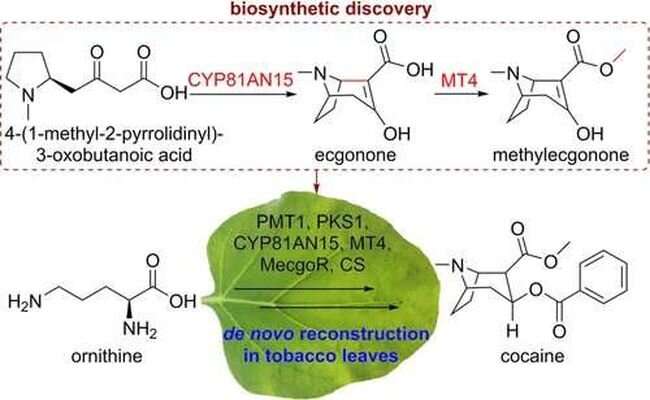November 30, 2022 report
Cocaine synthesized in a tobacco plant

A team of researchers at the Chinese Academy of Sciences, working with a colleague from Syngenta Jealott's Hill International Research Centre in the U.K., has developed a way to synthesize cocaine using a tobacco plant. The group describes how they synthesized the notorious drug and possible uses for their process in their paper published in Journal of the American Chemical Society.
Because growing coca plants to produce cocaine involves a lot of labor, scientists have, over the past century, been looking for a way to produce it in the lab. Unfortunately, such efforts have proved fruitless due to the complex biochemistry of the coca plant and its valuable byproduct. Now, in this new effort, the researchers have not only figured out the biochemistry of the plant and the cocaine it produces, but have synthesized small amounts of cocaine by genetically engineering a type of tobacco plant to produce the material in its leaves.
In studying the coca plant, the researchers discovered that the cocaine that winds up in its leaves is not produced by elements in the plant converting 4-(1-methyl-2-pyrrolidinyl)-3-oxobutanoic acid to hyoscyamine, as has been thought. They found that it is instead produced by the two enzymes, EnMT4 and EnCYP81AN15.
To prove their discovery, the group genetically engineered a tobacco plant to produce the two enzymes in its leaves, which resulted in the production of small amounts of cocaine (with assistance from a substance also produced in the plant called ornithine, which is similar to the precursor in the coca plant).
The researchers note that their efforts were focused on synthesizing cocaine to produce it for use in medical applications, such as pain control. Also, notably, the process they used to produce the cocaine in tobacco plants is far too technical for use by criminals determined to produce the drug illegally.
The team also notes that the amount of cocaine produced by the tobacco plant was far too low for use on an industrial scale; thus, their work will continue. Not mentioned in the paper is the possibility of synthesizing the two enzymes produced by both the coca and engineered tobacco plant as a more direct way to synthesize cocaine.
More information: Yong-Jiang Wang et al, Discovery and Engineering of the Cocaine Biosynthetic Pathway, Journal of the American Chemical Society (2022). DOI: 10.1021/jacs.2c09091
Journal information: Journal of the American Chemical Society
© 2022 Science X Network





















